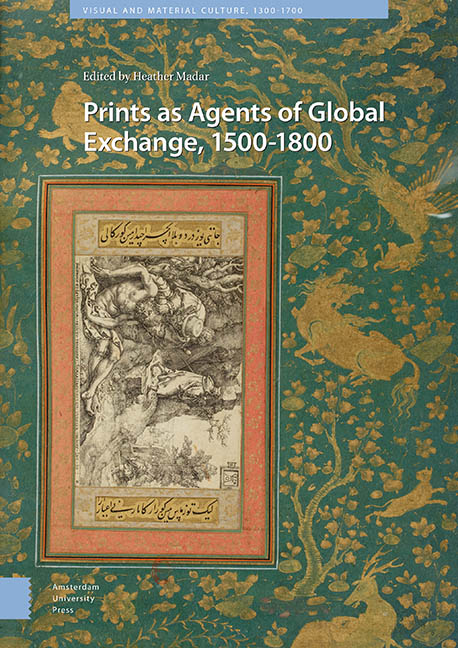Book contents
- Frontmatter
- Table of Contents
- List of illustrations
- Introduction
- 1 Concealing and Revealing the Female Body in European Prints and Mughal Paintings
- 2 The Sultan’s Face Looks East and West: European Prints and Ottoman Sultan Portraiture
- 3 From Europe to Persia and Back Again: Border-Crossing Prints and the Asymmetries of Early Modern Cultural Encounter
- 4 The Dissemination of Western European Prints Eastward: The Armenian Case
- 5 The Catholic Reformation and Japanese Hidden Christians: Books as Historical Ties
- 6 (Re)framing the Virgin of Guadalupe: The Concurrence of Early Modern Prints and Colonial Devotions in Creating the Virgin
- 7 Hidden Resemblances: Re-contextualized and Re-framed: Diego de Valadés’ Cross Cultural Exchange
- 8 The Practice of Art: Auxiliary Plastic Models and Prints in Italy, Spain, and Peru
- 9 Ink and Feathers: Prints, Printed Books, and Mexican Featherwork
- Index
2 - The Sultan’s Face Looks East and West: European Prints and Ottoman Sultan Portraiture
Published online by Cambridge University Press: 16 December 2021
- Frontmatter
- Table of Contents
- List of illustrations
- Introduction
- 1 Concealing and Revealing the Female Body in European Prints and Mughal Paintings
- 2 The Sultan’s Face Looks East and West: European Prints and Ottoman Sultan Portraiture
- 3 From Europe to Persia and Back Again: Border-Crossing Prints and the Asymmetries of Early Modern Cultural Encounter
- 4 The Dissemination of Western European Prints Eastward: The Armenian Case
- 5 The Catholic Reformation and Japanese Hidden Christians: Books as Historical Ties
- 6 (Re)framing the Virgin of Guadalupe: The Concurrence of Early Modern Prints and Colonial Devotions in Creating the Virgin
- 7 Hidden Resemblances: Re-contextualized and Re-framed: Diego de Valadés’ Cross Cultural Exchange
- 8 The Practice of Art: Auxiliary Plastic Models and Prints in Italy, Spain, and Peru
- 9 Ink and Feathers: Prints, Printed Books, and Mexican Featherwork
- Index
Summary
Abstract
Sultanic portraiture is a distinctive element of Ottoman art that was fed by cross-cultural contact. This genre was shaped in formative ways in the fifteenth century by Mehmed II, whose portraits reflect a hybrid of Italian and Timurid portrait conventions. The sixteenth century saw painted and printed series of Ottoman sultan portraits by European artists as well as painted series originating from the Ottoman context. These images played a significant role in the further development of Ottoman sultan portraiture through a complex back and forth movement of images, creating an important, multi-directional moment of visual exchange between the Ottoman Empire and Renaissance Europe. The role of prints seen here also underscores the under-explored significance of printed materials in these types of exchanges.
Keywords: Mehmed II, Suleyman the Magnificent, Paolo Giovio, Seyyid Lokman, global Renaissance, Fatih Album
Print technology in Europe was linked to the Ottoman Empire almost from the moment of its inception. An anti-Ottoman polemic, Eyn manung der Cristenheit widder die durken (A Warning to Christendom Against the Turks) from 1454 was one of Gutenberg's earliest printed pamphlets. Gutenberg also printed broadsides in 1454-1455 to support indulgences that were intended to raise money for the defense of Cyprus against the Ottomans. Within only a few decades of the invention of engraving, European prints were brought to the Ottoman capital and seemingly into the hands of the reigning Ottoman sultan, the famously pluralistic Mehmed II. Yet the late date of the establishment of printing presses in Istanbul and widespread perceptions of the hostility of the Islamic world to print technology have led to a general lack of discussion of the role of prints – both Western European and locally produced – within the Ottoman Empire. Yet it is clear that prints played a much more significant role within the Ottoman Empire and on Ottoman visual and textual culture than has been commonly assumed. A particularly clear and rich example of the cross-cultural movement of prints between Europe and the Ottoman Empire during the early modern period is provided by the complex interactions between European and Ottoman produced images of the Ottoman sultans in the fifteenth and sixteenth centuries.
- Type
- Chapter
- Information
- Prints as Agents of Global Exchange1500-1800, pp. 73 - 106Publisher: Amsterdam University PressPrint publication year: 2021



